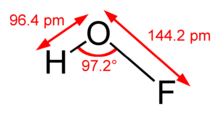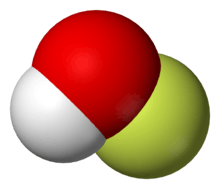Hypofluorous acid
Hypofluorous acid, chemical formula HOF, is the only known oxoacid of fluorine and the only known oxoacid which the main atom gains electrons from oxygen to create a negative oxidation state. The oxidation state of the oxygen in hypofluorites is 0.The oxidation state of H is +1 and Oxidation State of Fluorine is -1. It is also the only hypohalous acid that can be isolated as a solid. HOF is an intermediate in the oxidation of water by fluorine, which produces hydrogen fluoride, oxygen difluoride, hydrogen peroxide, ozone and oxygen. HOF is explosive at room temperature, forming HF and O2:
- 2 HOF → 2 HF + O2[1]
 Gas-phase structure | |
 | |
| Names | |
|---|---|
| IUPAC name
Hypofluorous acid | |
| Other names
Hydrogen hypofluorite Hydrogen fluorate(-I) Fluoric(-I) acid Hydrogen monofluoroxygenate(0) hydroxyl fluoride | |
| Identifiers | |
3D model (JSmol) |
|
| ChemSpider | |
PubChem CID |
|
CompTox Dashboard (EPA) |
|
| |
| |
| Properties | |
| HOF | |
| Molar mass | 36.0057 g mol−1 |
| Appearance | pale yellow liquid above −117 °C white solid below −117 °C |
| Melting point | −117 °C (−179 °F; 156 K) |
| Boiling point | decomposes at 0 °C |
| Structure | |
| Cs | |
| Hazards | |
| Main hazards | strong oxidizer, corrosive |
| NFPA 704 (fire diamond) | |
| Related compounds | |
Other cations |
lithium hypofluorite |
Related compounds |
hypochlorous acid nitroxyl hydrogen cyanide formaldehyde |
Except where otherwise noted, data are given for materials in their standard state (at 25 °C [77 °F], 100 kPa). | |
| Infobox references | |
It was isolated in the pure form by passing F2 gas over ice at −40 °C, collecting the HOF gas, and condensing it:
- F2 + H2O → HOF + HF
The compound has been characterized in the solid phase by X-ray crystallography[1] as a bent molecule with an angle of 101°. The O–F and O–H bond lengths are 144.2 and 96.4 picometres, respectively. The solid framework consists of chains with O–H···O linkages. The structure has also been analyzed in the gas phase, a state in which the H–O–F bond angle is slightly narrower (97.2°).
Hypofluorous acid in acetonitrile (generated in situ by passing gaseous fluorine through "wet" acetonitrile) is commonly known as Rozen's reagent.[2][3][4]
Hypofluorites
Hypofluorites are formally derivatives of OF−, which is the conjugate base of hypofluorous acid. One example is trifluoromethyl hypofluorite (CF3OF).
See also
- Hypochlorous acid, a related compound that is more technologically important but has not been obtained in pure form.
References
- W. Poll; G. Pawelke; D. Mootz; E. H. Appelman (1988). "The Crystal Structure of Hypofluorous Acid : Chain Formation by O-H · · · O Hydrogen Bonds". Angew. Chem. Int. Ed. Engl. 27 (3): 392–3. doi:10.1002/anie.198803921.
- Rozen, Shlomo (2001). "Hypofluorous Acid". Encyclopedia of Reagents for Organic Synthesis. doi:10.1002/047084289X.rh074. ISBN 0471936235.
- Rozen, Shlomo (2014). "HOF·CH3CN: Probably the Best Oxygen Transfer Agent Organic Chemistry Has To Offer". Acc. Chem. Res. 47 (8): 2378–2389. doi:10.1021/ar500107b. PMID 24871453.
- Singh, Raman; Kaur, Rajneesh; Gupta, Tarang; Kulbir, Kulbir; Singh, Kuldeep (2019). "Applications of Rozen's Reagent in Oxygen-Transfer and C-H Activation Reactions". Synthesis. 51 (2): 371–383. doi:10.1055/s-0037-1609638.
